
Rf-modulator

Two integrated circuit (IC) RF modulators convert a suitable baseband video and audio signal to a low VHF modulated carrier, specifically Channel 2 through 6 in the U.S. and Channels 1 through 3 in Japan. The LM1889 and LM2889 are identical in terms of RF modulation functionality, including pin configurations, and can provide either of two RF carriers with a switch selection for the desired carrier frequency. The LM1889 features a crystal-controlled chroma subcarrier oscillator and a balanced modulator for encoding red through yellow (R through Y) or U and V color difference signals. Additionally, a sound intercarrier frequency LC oscillator is modulated using an external varactor diode. The LM2889 replaces the chroma subcarrier function of the LM1889 with a video de-restoration clamp and an internal frequency-modulated sound intercarrier oscillator.
The circuit employs two RF modulators, the LM1889 and LM2889, which are designed to facilitate the modulation of baseband video and audio signals into low VHF frequencies suitable for television broadcasting. The modulation process is essential for transmitting video signals over the airwaves, allowing for compatibility with standard television receivers.
The LM1889 integrates a crystal-controlled chroma subcarrier oscillator, which is crucial for encoding color information in the video signal. This oscillator generates a stable frequency that is used to modulate the color difference signals (U and V), ensuring accurate color representation in the transmitted video. The balanced modulator within the LM1889 is responsible for combining the video signal with the chroma subcarrier, effectively creating a modulated RF signal that can be transmitted.
In contrast, the LM2889 modifies this approach by incorporating a video de-restoration clamp, which helps maintain the integrity of the video signal during transmission. This clamp ensures that any variations in the video signal are corrected, enhancing the quality of the output. Furthermore, the internal frequency-modulated sound intercarrier oscillator in the LM2889 allows for the modulation of audio signals, ensuring they are transmitted alongside the video without the need for external components.
Both ICs provide flexibility in carrier frequency selection, allowing for easy adaptation to different broadcasting standards. The switch selection feature enables users to choose between two RF carrier frequencies, accommodating various transmission requirements and ensuring compliance with regional broadcasting regulations.
Overall, the design and functionality of the LM1889 and LM2889 RF modulators are essential for effective video and audio transmission in VHF channels, providing reliable performance in both U.S. and Japanese broadcasting environments.Two IC rf modulators convert a suitable baseband video and audio signal up to a low VHF modulated carrier-Channel2 through 6 in the U.S., and 1 through 3 in japan-the LM1889 and the LM2889. Both !Cs are identical regarding the rf modulation function, including pin outs, and can provide either of two rf carriers with de switch selection of the desired carrier frequency.
The LM1889 includes a crystal-controlled chroma subcarrier oscillator and balanced modulator for encoding R through Y or U and V color difference signals. A sound intercarrier frequency lc oscillator is modulated using an external varactor diode. The LM2889 replaces the chroma subcarrier function of the LM1889 with a video de restoration clamp and an internal frequency-modulated sound intercarrier oscillator. 🔗 External reference
The circuit employs two RF modulators, the LM1889 and LM2889, which are designed to facilitate the modulation of baseband video and audio signals into low VHF frequencies suitable for television broadcasting. The modulation process is essential for transmitting video signals over the airwaves, allowing for compatibility with standard television receivers.
The LM1889 integrates a crystal-controlled chroma subcarrier oscillator, which is crucial for encoding color information in the video signal. This oscillator generates a stable frequency that is used to modulate the color difference signals (U and V), ensuring accurate color representation in the transmitted video. The balanced modulator within the LM1889 is responsible for combining the video signal with the chroma subcarrier, effectively creating a modulated RF signal that can be transmitted.
In contrast, the LM2889 modifies this approach by incorporating a video de-restoration clamp, which helps maintain the integrity of the video signal during transmission. This clamp ensures that any variations in the video signal are corrected, enhancing the quality of the output. Furthermore, the internal frequency-modulated sound intercarrier oscillator in the LM2889 allows for the modulation of audio signals, ensuring they are transmitted alongside the video without the need for external components.
Both ICs provide flexibility in carrier frequency selection, allowing for easy adaptation to different broadcasting standards. The switch selection feature enables users to choose between two RF carrier frequencies, accommodating various transmission requirements and ensuring compliance with regional broadcasting regulations.
Overall, the design and functionality of the LM1889 and LM2889 RF modulators are essential for effective video and audio transmission in VHF channels, providing reliable performance in both U.S. and Japanese broadcasting environments.Two IC rf modulators convert a suitable baseband video and audio signal up to a low VHF modulated carrier-Channel2 through 6 in the U.S., and 1 through 3 in japan-the LM1889 and the LM2889. Both !Cs are identical regarding the rf modulation function, including pin outs, and can provide either of two rf carriers with de switch selection of the desired carrier frequency.
The LM1889 includes a crystal-controlled chroma subcarrier oscillator and balanced modulator for encoding R through Y or U and V color difference signals. A sound intercarrier frequency lc oscillator is modulated using an external varactor diode. The LM2889 replaces the chroma subcarrier function of the LM1889 with a video de restoration clamp and an internal frequency-modulated sound intercarrier oscillator. 🔗 External reference
